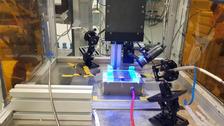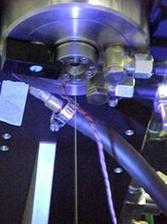Experimental setup at PETRA beamline P03: UV light triggers photopolymerisation; progress is monitored at regular intervals with X-ray light from PETRA III (Photo: DESY, KTH/C. Brett).
For the first time, an international research team succeeded in observing photopolymerisation in technically relevant polymers live at PETRA III. The new method enables researchers to decipher the exact processes involved in photopolymerisation, thus paving the way for new tailor-made polymers. What is special about this is that although the team used the bright X-ray light from PETRA III for the investigation, it had no influence on the observed process.
Polymers are everywhere. Biopolymers are found in organisms and silk, artificial polymers insulate houses or shape the interior of cars. What they have in common is that they consist of long chains of molecules that form from smaller molecules in the process of polymerisation. Polymer properties such as hardness or elasticity can sometimes be adjusted over a wide range by changing the ambient conditions during polymerisation. This makes polymers and their applications extremely diverse.
Photopolymers are materials that polymerise under the influence of light. They are widely used, for example, as dental filling material by doctors, which hardens rapidly under UV light, or in 3D printing, which enables high-strength, sometimes very complex components to be created layer by layer.
The polymerisation of the material is triggered by the energy of the light, i.e. the irradiated light must have a short wavelength. This is typical in the UV range around 300 nanometres. Microscopically, polymerisation is well understood, but for the nanoscopic processes of polymerisation there are only assumptions and models available so far. They have never been observed at the molecular level.
The research team from the Royal Institute of Technology Stockholm (KTH), DESY, the University of Milan and the Dutch technology company DSM has now overcome this problem: At PETRA III beamline P03, they applied two different monomer liquids in layers only 200 nm thick to a substrate and irradiated it with UV light. At short intervals they used the X-ray beams from PETRA III to map the structural changes during polymerisation without disturbing the process itself. "For the first time we were thus able to observe live that an initial heterogeneity of the monomers has a fundamental influence on the final morphology and physical properties of the resulting solid," explains DESY researcher Stephan Roth, who heads the P03 measuring station and teaches as a professor at KTH Stockholm. The researchers found out that a smaller gyration radius, i.e. smaller monomer bundles at the beginning of the illumination, leads to smoother surfaces of the polymer. “With PETRA III, we can find domains of different densities in the polymer, which - depending on the polymerisation conditions - are 10 to 200 nanometres in size. In the samples with smaller gyration radii, the polymer is much more homogeneously cross-linked because the momomers are even more mobile during polymerisation,” says Roth.
“The fundamental understanding of photopolymerisation on the nanoscale is the entry point for a wealth of novel, individually adapted photopolymers. This will pave the way for new solutions the world so desperately needs, like advanced radiation curing applications such as additive manufacturing and 5G communication lightguides,” says Rolf van Benthem, Corporate Science Fellow Macromolecular Sciences at the DSM Materials Science Center, Geleen (Netherlands).
For the researchers, the low-layer thickness of the monomer liquid is decisive for the breakthrough of observing polymerisation with X-rays on the nanoscale. With the help of an atomic force microscope, the scientists verified that the polymerisation in the areas illuminated by PETRA X-rays did not differ from those where only the UV light triggering the polymerisation arrived. The team plans to conduct further variants of its experiments for more detailed analysis.
(from DESY News)
Reference:
C.J. Brett, S. Montani, M. Schwartzkopf, R.A.T.M. van Benthem, J.F.G.A. Jansen, G. Griffini, S.V. Roth, M.K.G. Johansson: Revealing structural evolution occurring from photo-initiated polymer network formation. Commun Chem 3, 88 (2020). DOI: 10.1038/s42004-020-0335-9








